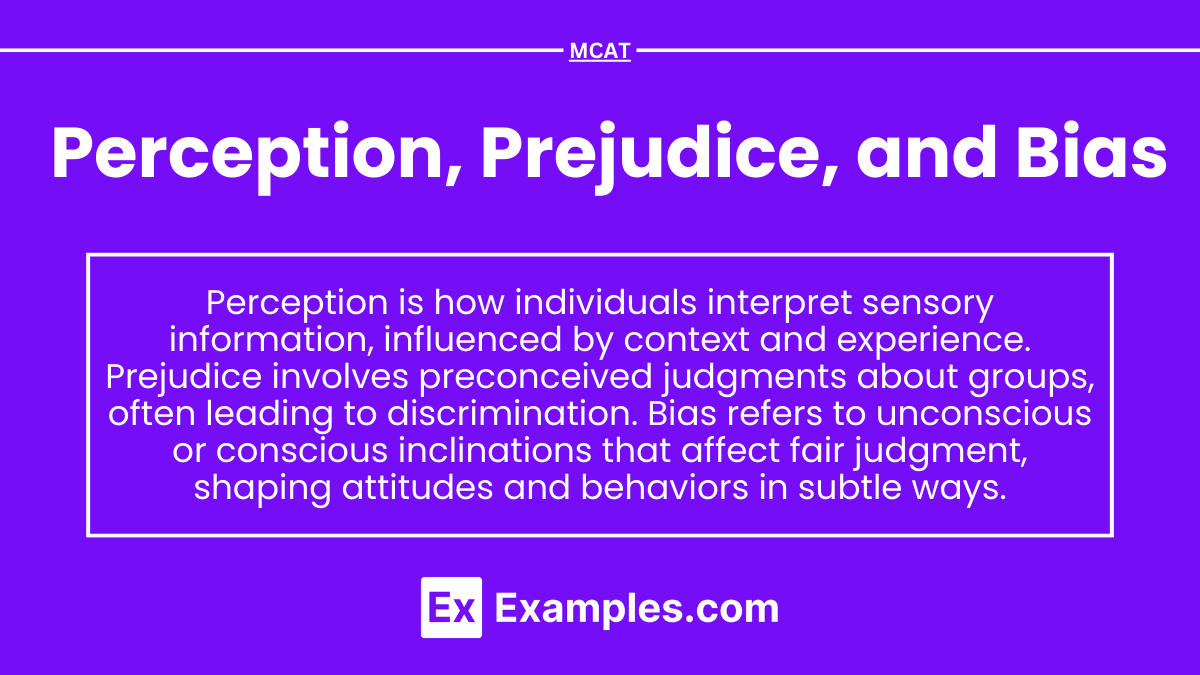Perception, prejudice, and bias shape our interactions and understanding of the world, influencing both conscious and unconscious reactions. Perception involves the process by which we interpret sensory information, forming a basis for judgment. Prejudice, however, arises when preconceived notions about individuals or groups distort this interpretation, often based on stereotypes rather than facts. Bias is a related tendency, manifesting as a systematic inclination or preference that affects decisions and actions. Understanding these dynamics is essential to addressing how they impact relationships, social structures, and even personal growth. Identifying and challenging prejudice and bias allows for more equitable, mindful interactions.
Learning Objectives
When studying "Perception, Prejudice, and Bias" for the MCAT, focus on understanding how these psychological factors influence human behavior, decision-making, and interactions. Learn how perception impacts the interpretation of sensory information, which forms the foundation for judgments and social understanding. Explore how prejudice stems from preconceived, often inaccurate beliefs about individuals or groups, and examine the effects of both conscious and unconscious biases on cognition and behavior. Recognize the role of stereotypes and how they can lead to discriminatory actions, and study methods for reducing bias, such as increasing awareness, empathy, and perspective-taking. Grasping these concepts will help in analyzing social interactions and understanding the psychological mechanisms that contribute to inequality and social dynamics.
1. Perception
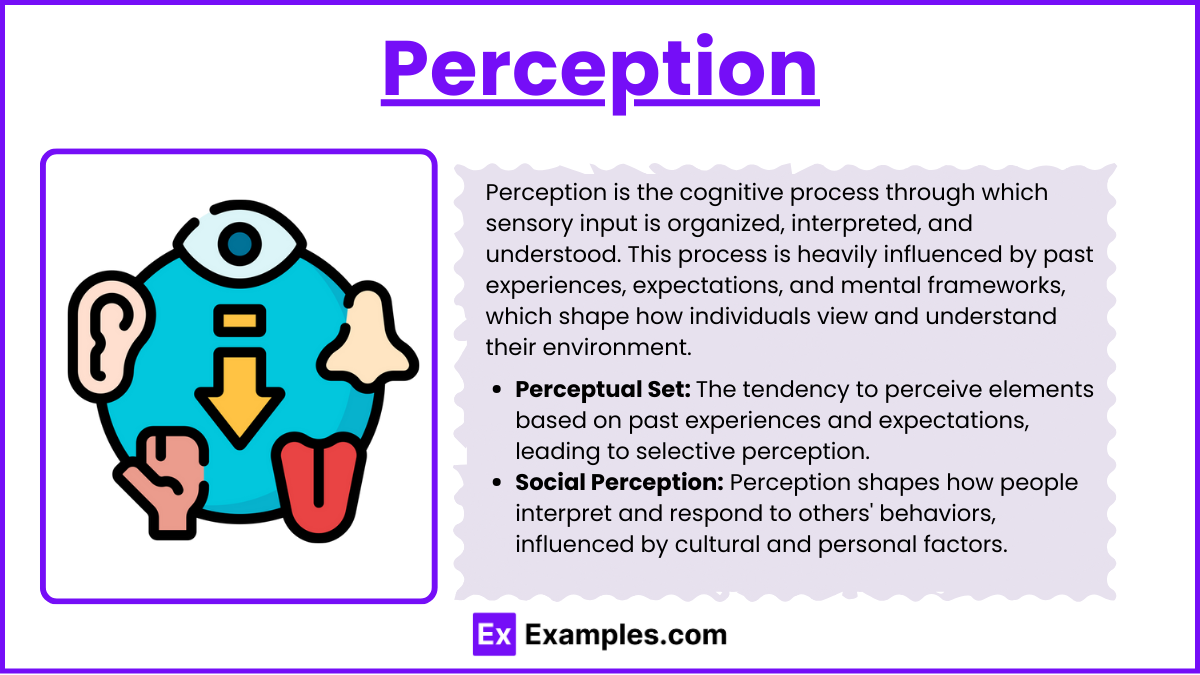
Definition: Perception is the cognitive process through which sensory input is organized, interpreted, and understood. This process is heavily influenced by past experiences, expectations, and mental frameworks, which shape how individuals view and understand their environment.
Perceptual Set: The readiness to perceive certain elements in a particular way, often based on context, past experiences, and expectations. Perceptual sets can lead to selective perception, where certain stimuli are ignored or emphasized depending on preconceived notions.
Social Perception: When applied to social interactions, perception impacts how individuals understand and react to others. This includes interpreting body language, facial expressions, and tone, which can vary across cultures and personal experiences.
2. Prejudice
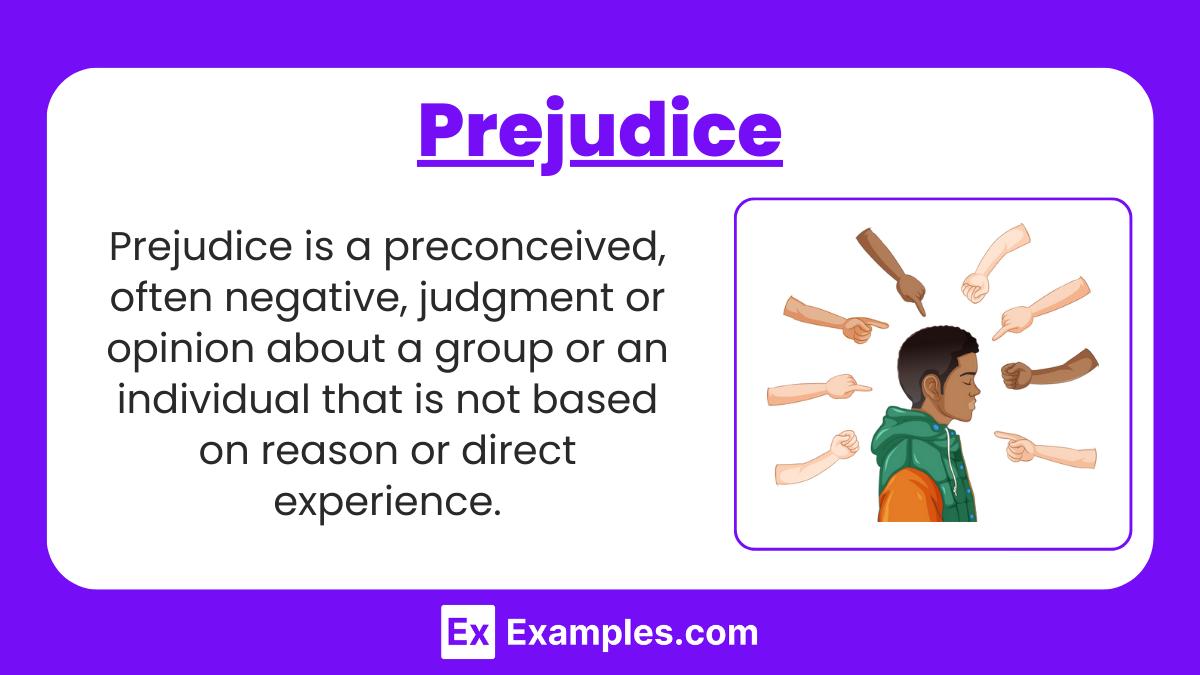
Definition: Prejudice is a preconceived, often negative, judgment or opinion about a group or an individual that is not based on reason or direct experience.
Cognitive, Affective, and Behavioral Components: Prejudice is generally broken down into:
Cognitive: Stereotypes or beliefs about a group (e.g., "All members of group X behave in a specific way").
Affective: Emotions associated with the group, often negative (e.g., feelings of dislike or fear).
Behavioral: The resulting discrimination or behavior toward the group (e.g., exclusion or avoidance).
Formation of Prejudice: It often arises from social influences, such as family or cultural norms, and cognitive biases that oversimplify complex social realities. Prejudice is reinforced by selective exposure to information that supports pre-existing biases.
3. Bias
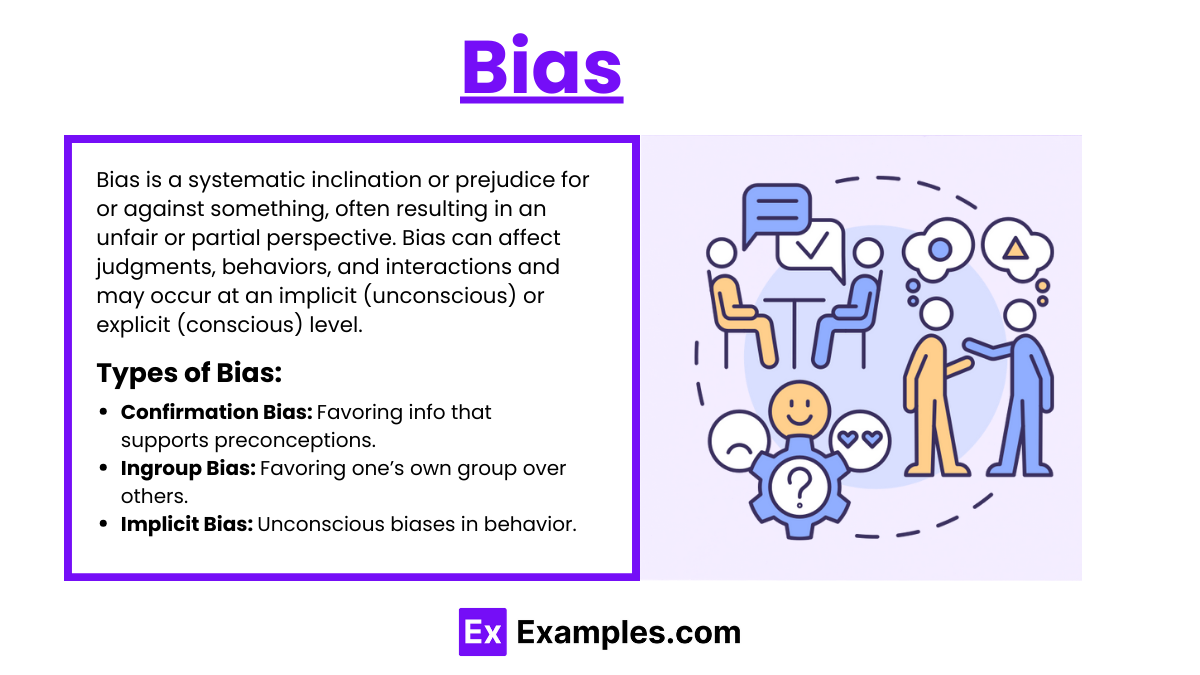
Definition: Bias is a systematic inclination or prejudice for or against something, often resulting in an unfair or partial perspective. Bias can affect judgments, behaviors, and interactions and may occur at an implicit (unconscious) or explicit (conscious) level.
Types of Bias:
Confirmation Bias: The tendency to search for or interpret information that confirms one’s preconceptions.
Ingroup Bias: Favoritism towards individuals within one's own group, leading to unequal treatment of outsiders.
Implicit Bias: Unconscious biases that can affect behavior and decision-making, often without the individual's awareness. Implicit biases are measured through tests like the Implicit Association Test (IAT).
Impact of Bias: Bias can shape interactions across various social domains, including healthcare, education, and criminal justice. Recognizing and addressing bias is essential for fair and equitable treatment in professional and personal contexts.
4. Influence on Behavior and Social Interactions
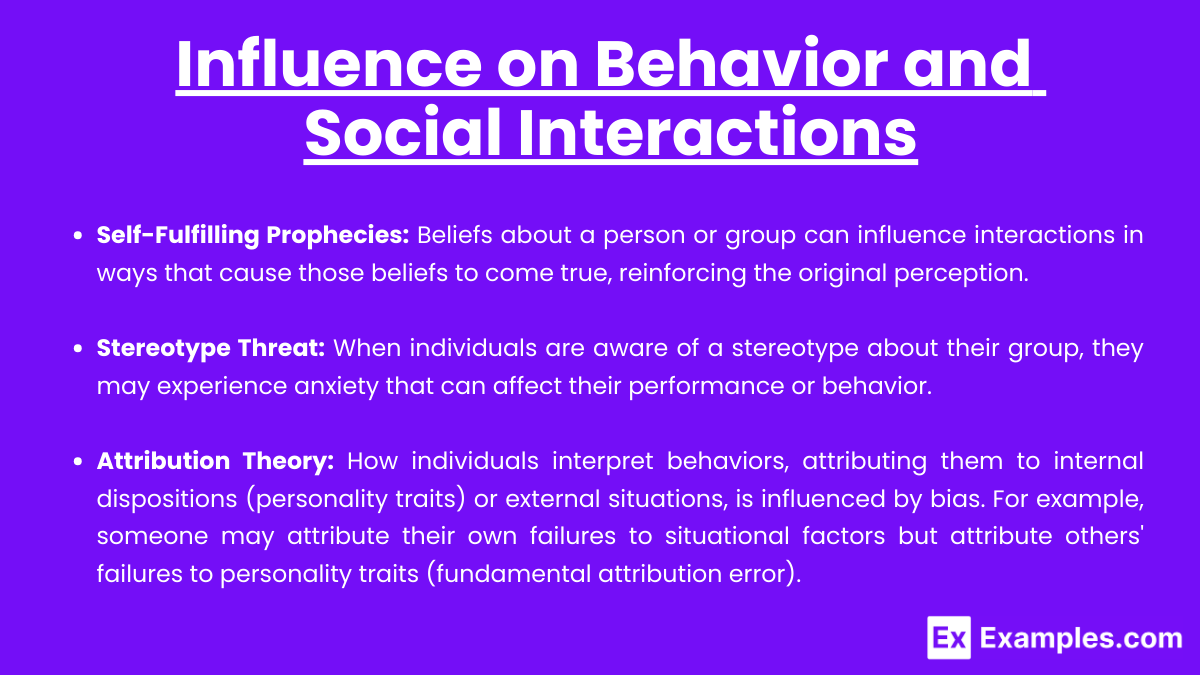
Self-Fulfilling Prophecies: Beliefs about a person or group can influence interactions in ways that cause those beliefs to come true, reinforcing the original perception.
Stereotype Threat: When individuals are aware of a stereotype about their group, they may experience anxiety that can affect their performance or behavior. This is common in academic and workplace settings and contributes to disparities in performance outcomes.
Attribution Theory: How individuals interpret behaviors, attributing them to internal dispositions (personality traits) or external situations, is influenced by bias. For example, someone may attribute their own failures to situational factors but attribute others' failures to personality traits (fundamental attribution error).
5. Strategies for Managing and Reducing Bias and Prejudice
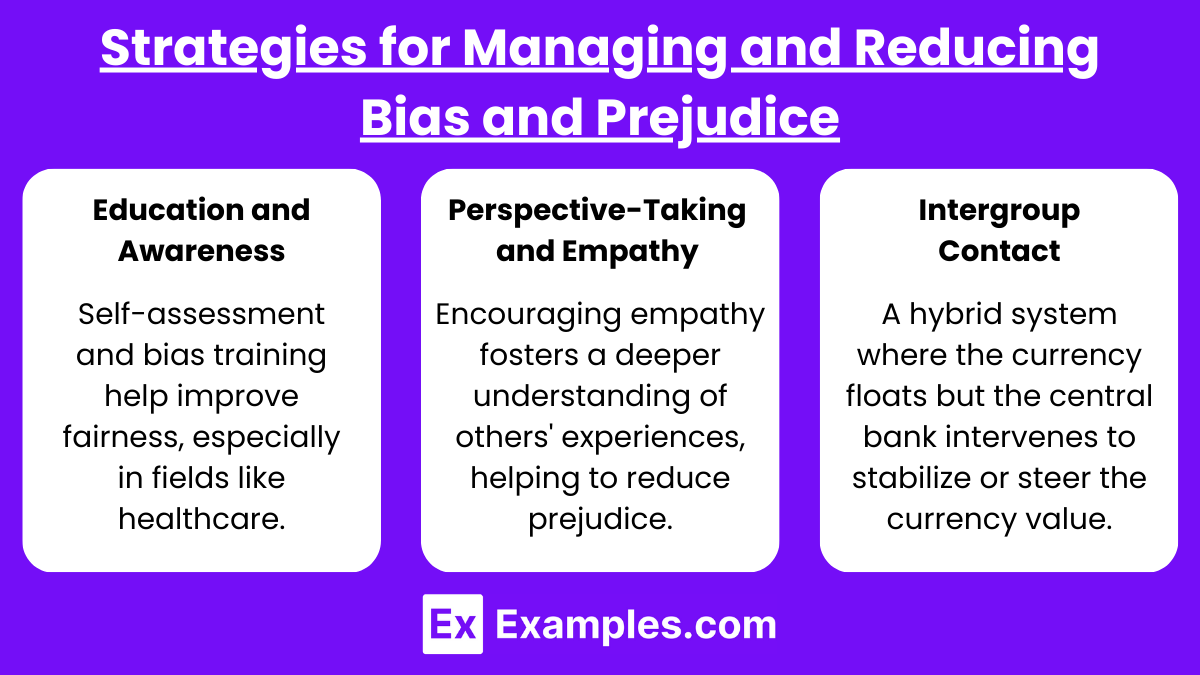
Education and Awareness: Understanding implicit biases through self-assessment and training can improve interpersonal skills, especially in fields like healthcare, where unbiased treatment is essential.
Perspective-Taking and Empathy: Encouraging empathy and understanding of others' experiences can reduce prejudice by promoting a more comprehensive understanding of individuals' circumstances.
Intergroup Contact: Direct, positive interaction between different groups under cooperative conditions can reduce prejudice, foster empathy, and reduce stereotypes.
Examples
Example 1. Medical Decision-Making and Implicit Bias
A doctor may unconsciously hold implicit biases about certain racial or ethnic groups, leading to disparities in treatment. For example, studies have shown that African American patients are less likely to receive adequate pain management because of implicit perceptions that they have a higher pain tolerance. This bias affects the quality of care, despite evidence showing that all patients, regardless of race, should be treated equally.
Example 2. Workplace Promotions and Ingroup Bias
In a corporate setting, a manager may favor employees who share similar backgrounds or social circles, exhibiting ingroup bias. For instance, if a manager consistently promotes employees who went to the same university as they did, this can lead to unfair opportunities for others. Despite qualifications, those outside the manager's social group may be perceived as less competent or capable, influencing promotion decisions.
Example 3. Educational Settings and Stereotype Threat
A female student in a math class may feel anxious about confirming negative stereotypes that women are not as good at math as men. This stereotype threat can undermine her performance, leading to lower test scores. Her anxiety is a direct result of the perceived stereotype, affecting her abilities and reinforcing the bias against women in STEM fields.
Example 4. Hiring Decisions and Confirmation Bias
During the interview process, a hiring manager might look for information that confirms their preconceived notion that a particular candidate fits or doesn’t fit the company culture. For example, if a manager believes that older candidates are not technologically savvy, they may focus on minor mistakes made by older applicants during the interview process, ignoring their overall experience and qualifications. This confirmation bias can result in unfair hiring practices.
Example 5. Social Interactions and the Fundamental Attribution Error
When someone observes a colleague arriving late to work, they might attribute it to the person being irresponsible or lazy, reflecting the fundamental attribution error. However, if they themselves arrive late, they are more likely to blame external factors, such as traffic or a family emergency. This bias in perceiving others’ behaviors can affect how relationships and reputations are formed within social and professional environments.
Practice Questions
Question 1
Which of the following best describes implicit bias?
A. A conscious belief about a group of people that one actively endorses
B. A hidden prejudice that operates unconsciously and influences behavior
C. An attitude formed from direct experiences that affect decision-making
D. A stereotype that people are aware of and openly admit
Answer: B. A hidden prejudice that operates unconsciously and influences behavior
Explanation: Implicit bias refers to unconscious attitudes or stereotypes that affect understanding, actions, and decisions without the person being aware of them. This type of bias operates outside of conscious control and can lead to discriminatory behaviors or judgments even in individuals who genuinely believe they are unbiased. Unlike explicit bias, which is a conscious belief or attitude (A and D), implicit bias occurs subconsciously. Option C refers to attitudes formed through direct experiences but does not specifically address the unconscious nature of implicit bias.
Question 2
Stereotype threat is most likely to occur when?
A. An individual is reminded of a positive stereotype about their group
B. An individual is unaware of any stereotypes about their group
C. An individual feels at risk of confirming a negative stereotype about their group
D. An individual is not part of any stereotyped group
Answer: C. An individual feels at risk of confirming a negative stereotype about their group
Explanation: Stereotype threat occurs when individuals are aware of a negative stereotype about their social group and feel anxiety or pressure that they may confirm that stereotype. This anxiety can negatively affect performance in areas like academics or sports. For example, a woman taking a math exam may underperform if reminded of the stereotype that women are worse at math. Option A refers to positive stereotypes, which may not produce the same level of anxiety. Option B is incorrect because stereotype threat relies on awareness of stereotypes, and D is incorrect because all people belong to groups that may be stereotyped.
Question 3
Which of the following scenarios best illustrates confirmation bias?
A. A student only pays attention to information that supports their existing beliefs about climate change
B. A manager gives equal attention to both positive and negative feedback before making a decision
C. A person is open to changing their opinion after hearing a new perspective
D. A researcher presents both sides of a debate objectively
Answer: A. A student only pays attention to information that supports their existing beliefs about climate change
Explanation: Confirmation bias refers to the tendency to search for, interpret, and recall information that confirms one’s pre-existing beliefs while ignoring evidence that contradicts those beliefs. In this scenario, the student is selectively focusing on information that aligns with their beliefs about climate change, while disregarding conflicting evidence. Option B describes fair decision-making, which is not influenced by confirmation bias. Options C and D represent openness to different perspectives, which is the opposite of confirmation bias.

